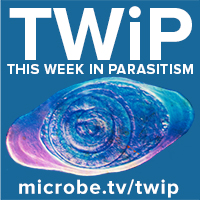The TWiP hosts solve the case of the Thai Woman With Red Bumps, and reveal that a master manipulator contacts ant brain tissue to control its behavior.
The TWiP professors solve the case of the Woman With Intracellular Ring Forms, and explore the role of Coxiella and Rickettsia endosymbionts in acquisition of Babesia by ticks.
The TWiP crew solves the case of the Ecuadorian with Immunodeficiency and Chronic Diarrhea, and discuss oral transmission of Chagas disease in mice.
Justin joins the TWiP team to solve the case of the Gentleman with B cell Lymphoma, and consider the finding of Dracunculus species in river otters from Arkansas.
Vincent and Daniel solve the case of the Man in the City with Groin Rash, catch up on the long backlog of email, and present a new case, possibly the most complex one yet on the show.
The TWiP peeps solve the case of the Panamanian Mother with Steatorrhea, and reveal new monoclonal antibodies that effectively block malarial infection.
The Podfessors solve the case of the Itchy Child from Panama, and discuss competition for blood in human malaria-helminth co-infections.
The TWiPers solve the case of the Panamanian Man With Leg Ulcer, and describe how a crab predator preferentially feeds on parasite infected prey – even though the parasite makes them faster!
Shivang joins the TWiP triumvirate to solve the case of the New Yorker With Rash and Pins and Needles, and reveal how agrochemicals increase risk of human schistosomiasis by causing high snail density.
TWiP 148: Weep and sweep
- March 7, 2018
- Tagged as: B1 cell, B2 cell, goblet cell, hookworm, IgE, mast cell, mucus, parasite, parasitism, parasitology, Stronglyoides
The TWiP-tologists solve the case of the Child in South America With Belly Pain, and reveal how B1 cell IgE blocks parasite clearance by inhibiting mast cell activation by B2 cell IgE.




